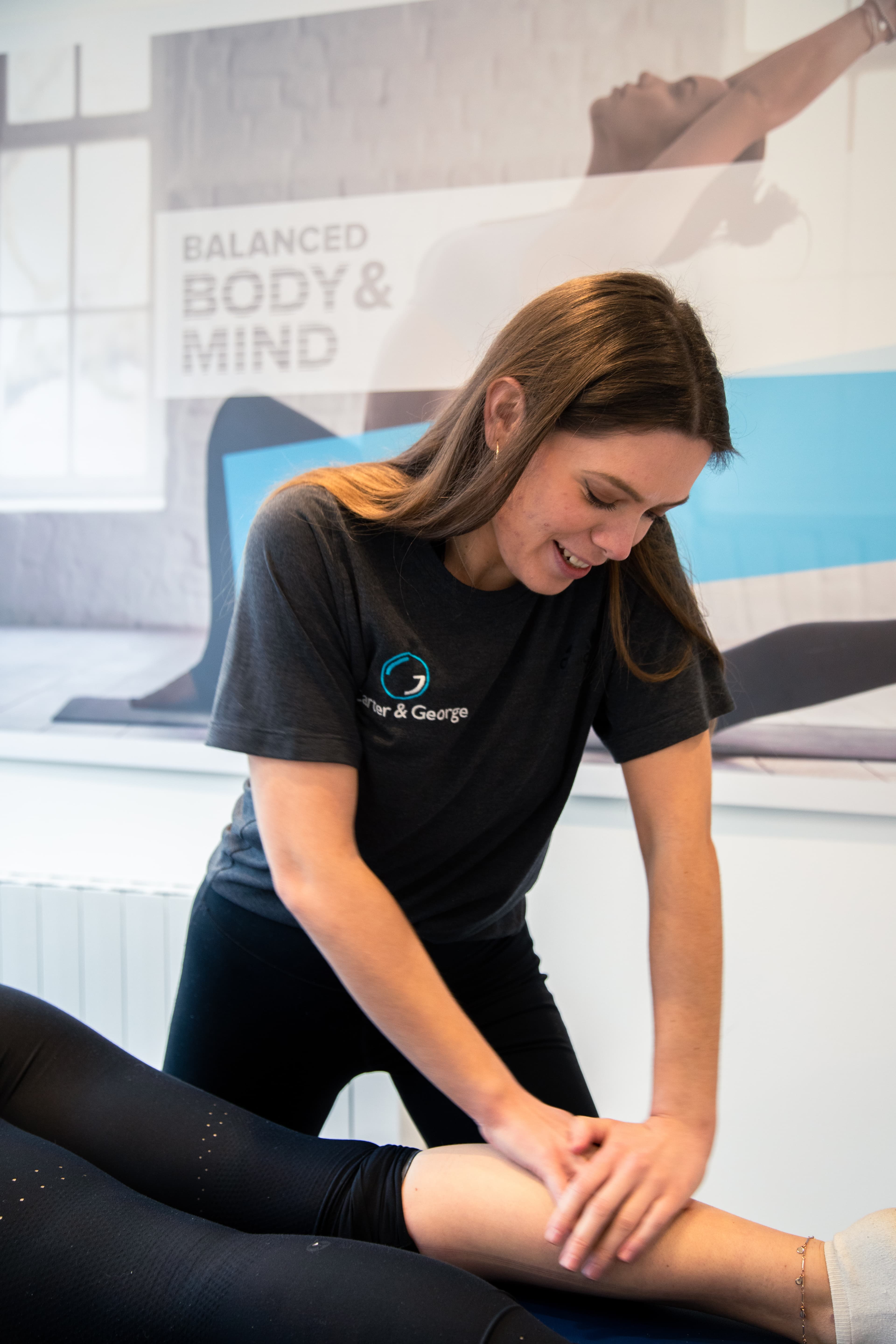Related Posts
Marathon season is here! And with it, knee pain! Introducing Runners Knee…
Better understands the symptoms, causes, risk factors and treatments for runners knee to keep your training on track.
You’ve heard if it, but what is an ACL Injury?
ACL injuries are commonly seen in sports involving quick direction changes, jumping, or dodging. Find out the causes, symptoms, and mechanisms of ACL injuries as well as treatment options based on age and athletic level.
Understanding Knee Injuries in Rugby
Dive into what makes knee injuries such a concern for rugby players and how they can be prevented and treated.
Hamstring Injury Management

What is a hamstring injury?
A hamstring injury refers to a strain or tear in the muscles or tendons, which make up the hamstring group at the back of the thigh. This type of injury is prevalent among athletes, particularly those involved in sports activities that require running, jumping, or sudden stopping and starting. Severity can range from a minor strain (a small tear or stretch of the muscle fibers), which might cause discomfort or slight loss of function, to a complete tear of the muscle, which can cause severe pain and loss of function.
Causes of Hamstring Injuries
The main causes of hamstring injuries arise from a combination of muscle overload and muscle imbalances. Activities that involve explosive movements such as sprinting, jumping, or making a sudden change in direction are particularly risky.
These actions can cause the muscle to stretch beyond its limit, leading to a strain or tear. Hamstring injuries may also occur due to inadequate warm-up before participating in strenuous activities, leading to insufficient muscle elasticity or tight muscles during high-intensity tasks .
Muscle Imbalances
Additionally, muscle imbalances, where the quadriceps (muscles at the front of the thigh) are disproportionately stronger than the hamstrings, can also contribute to the risk of injury as it places undue stress on the hamstrings.
 Understanding the Hamstring
Understanding the Hamstring
The hamstring is a group of three muscles located at the back of the thigh, extending from the hip to the knee. These muscles work together to enable the bending of the knee and extending of the hip, both crucial movements in walking, running, and jumping.
The role of the hamstring in physical activities is often understated, yet it is fundamental. These muscles are heavily utilized during various types of exercises and sports that involve running or jumping. In running, for example, the hamstrings are responsible for the key action of propelling the body forward.
They work in concert with the quadriceps to control the motion of the leg, allowing the runner to maintain balance, speed, and direction. Similarly, in activities such as jumping or kicking, the hamstrings’ ability to extend the hip and bend the knee provides the necessary force to perform these movements. This is why maintaining good hamstring health and strength is integral to overall athletic performance and mobility.
Types of Hamstring Injuries
A hamstring strain is the most common type of hamstring injury, typically characterized by a sudden sharp pain at the back of the thigh during physical activity.
This occurs when the hamstring muscles or tendons are overstretched, leading to a tear in the muscle fibers. Strains are graded on a scale of 1 to 3, with grade 1 being a mild strain with few torn fibers, and grade 3 being a severe strain involving a complete tear of the muscle or tendon.
Symptoms may include pain and swelling, bruising, and in severe cases, difficulty in walking or even standing. Hamstring strains are most prevalent among athletes who participate in sports that require sprinting or high-speed running, sudden stopping and starting, or jumping.
Hamstring tears, usually categorized as grade 3 strains, entail a complete rupture of the muscle or tendon, rendering the most significant damage in the spectrum of hamstring injuries. This type of injury is often accompanied by a popping or snapping sensation at the time of injury, followed by intense pain.
The affected area may also swell, bruise, or appear discolored. The severity of the tear significantly impedes mobility, making it challenging to walk or even stand. Immediate medical attention is crucial to not make the injury worse or cause further damage and plan a suitable rehabilitation process to regain strength and function.
Signs and Symptoms of Hamstring Injuries
Signs and symptoms of hamstring injuries can vary depending on the severity and type of injury, but commonly include:
Pain and discomfort: This is typically the first sign of a hamstring injury. The pain may be sudden and sharp during physical activity, particularly during running or jumping, signaling a strain or tear. This pain may persist as a constant ache or discomfort even at rest, particularly when sitting or sleeping.
Swelling and bruises: Following the initial injury, swelling may occur at the injured area as the body’s response to inflammation and injury. This swelling can be accompanied by bruising, indicating internal bleeding from the damaged muscle fibers. The area may also be tender to touch.
Hamstring weakness: An injured hamstring may result in a marked decrease in strength of the hamstring muscle group. This weakness can limit the ability to perform activities that involve bending the knee or extending the hip, such as running, jumping, or even climbing stairs. In severe cases involving a complete tear, the individual may be unable to bear weight on the affected leg, making standing or walking difficult.
Risk Factors for Hamstring Injuries
Hamstring injuries have a high recurrence rate, with various studies indicating that one of the most prominent risk factors for a hamstring injury is a previous one. This is because the healing process may result in the formation of scar tissue in the injured area, which lacks the flexibility of the original muscle tissue.
Consequently, the healed area may be vulnerable to reinjury, especially if one returns to high-intensity sport or activities before the muscle has fully healed. Furthermore, without targeted rehabilitation that includes strength training and flexibility exercises, the muscle may have residual weakness or tightness that increases the risk of another injury. Therefore, it is crucial to follow a comprehensive rehabilitation program after a hamstring injury to reduce the likelihood of recurrence.
Insufficient flexibility or strength in the hamstring muscles can significantly elevate the risk of injuries. This is because such deficiencies can create an imbalance, overloading the hamstrings and making them more prone to strains and tears.
Lack of flexibility: Tight hamstrings limit the range of motion in the hip joint and increase the tension in the muscle. When a motion calls for more flexibility than the hamstrings can provide, the muscles can become overstretched, potentially resulting in a strain or tear. For instance, athletes involved in sports that require extensive stretching of the hamstrings, like ballet and gymnastics, are often at a higher risk of hamstring injuries. Hence, incorporating regular stretching exercises into one’s fitness regime is essential to maintain hamstring flexibility and reduce the likelihood of injuries.
Lack of strength: Weak hamstrings are less capable of withstanding the stresses of physical activity, particularly those that involve running or jumping. If the hamstrings are weaker than the quadriceps (the muscles at the front of the thigh), this imbalance can place too much strain on the hamstrings during activities, leading to injuries. Resolving this imbalance typically involves incorporating hamstring-strengthening exercises into one’s workout routine, which can bolster the muscles’ resilience and decrease the risk of injury.
Overuse injuries or a sudden increase in the intensity or frequency of physical activity can put an individual at a higher risk of hamstring injuries. When the hamstring muscles are subjected to repetitive strain or stress, it can lead to microscopic tears in the muscle fibers, precipitating an overuse injury. Furthermore, abruptly stepping up the level of physical activity without adequate conditioning or preparation can overstretch the muscles or tendons, leading to strains or tears. It’s crucial to gradually increase the intensity and duration of workouts, allowing the muscles to adapt and strengthen, to mitigate the risk of hamstring injuries.
The Process of Diagnosing Hamstring Injuries
Diagnosing a hamstring injury typically involves a thorough physical examination and a comprehensive review of the patient’s medical history. The physiotherapist may conduct tests to evaluate the pain and sensitivity, muscle strength, and range of motion in the affected area.
They may ask about the circumstances of the injury, the nature and location of the pain, and any previous hamstring injuries. Visual signs such as swelling and bruising can also inform the diagnosis. For more severe injuries, imaging tests such as ultrasound, X-ray, or MRI may be used to assess the extent of the injury, including any muscle or tendon tears. It’s important to get a precise diagnosis to ensure an appropriate treatment plan.
 Hamstring Injury Treatment
Hamstring Injury Treatment
Physiotherapists and sports therapists play a vital role in the treatment of hamstring injuries. Initially, they focus on pain management and swelling reduction, commonly employing the RICE method (Rest, Ice, Compression, and Elevation). Once the acute phase of the injury has passed, therapists design a tailored rehabilitation program, which typically includes strength and flexibility exercises to restore muscle function and prevent re-injury.
Manual therapy techniques, such as massage and mobilization, may be used to reduce muscle tension and improve circulation to the affected area. In severe cases, where surgery is required, physiotherapists guide post-operative recovery, helping the client gradually regain strength, flexibility, and confidence in using the injured muscle.
Prevention of Hamstring Injuries
Strength and conditioning coaches play a pivotal role in the prevention of hamstring injuries. They create targeted exercise programs that aim to strengthen the hamstring muscles and enhance their flexibility, thus reducing the risk of strains and tears. These trainers also help athletes develop proper movement mechanics, which can significantly reduce the stress on the hamstring muscles during physical activity.
Furthermore, they instruct and monitor athletes to ensure that they are gradually increasing the intensity of their workouts, which is a critical component in preventing overuse injuries. By working closely with athletes, strength and conditioning coaches can significantly decrease the likelihood of hamstring injuries.
 Case Study: Ben Chilwell’s Hamstring Injury
Case Study: Ben Chilwell’s Hamstring Injury
In the realm of professional football, hamstring injuries are quite common due to the high-intensity nature of the sport. One such example was the hamstring injury of Ben Chilwell while playing for Chelsea FC during the EFL Cup against Brighton. Chilwell, underwent imaging and was forced off. Chilwell missed three months last season with a hamstring problem, limiting him to just 23 Premier League appearances.
 Sports Injuries at Carter & George
Sports Injuries at Carter & George
At Carter & George, we treat many sports injuries. Our expert team of physiotherapists and sports therapists utilize the latest techniques and therapies to offer comprehensive, tailored treatment plans.
We are committed to not only treating the injury but also to understanding its root causes and preventing recurrence. Whether you’re a professional athlete or a fitness enthusiast, we strive to let you go back to your sport as quickly, safely, and effectively as possible. Our prime focus is to optimize your performance and ensure your long-term well-being.